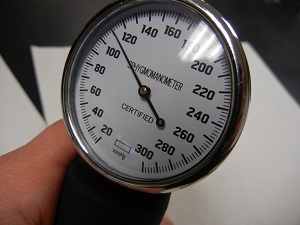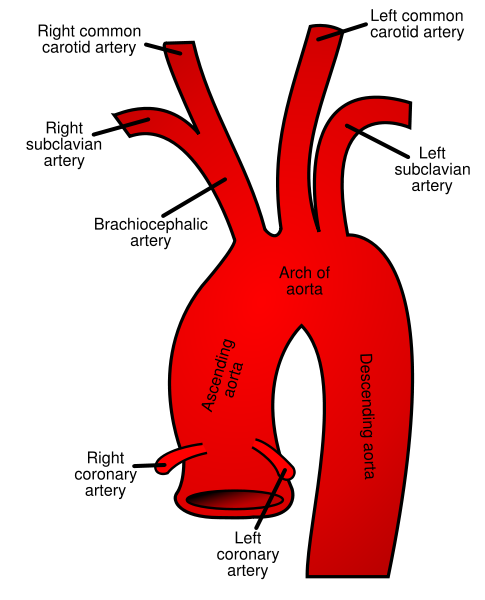Heart Actions
Cardiac Cycle - once complete heartbeat
Systolic pressure / diastolic pressure
Systolic occurs when blood is forced out of the left ventricle, and the aortic valve OPENS...this is the high number on a blood pressure reading
Diastolic occurs when the aortic valve closes and the ventricle relaxes, this is the lower number of the blood pressure reading.
Average (Normal) Blood Pressure = 120/80
Average heart rate = 72 bpm
The cusps (flaps) of the bicuspid and tricuspid valves are anchored to the ventricle walls by fibrous “cords” called chordate tendineae, which attach to the wall by papillary muscles. This prevents the valves from being pushed up into the atria during ventricular systole.
*The device used to measure blood pressure is a SPHYGMOMANOMETER

Factors affecting blood pressure:
1. Cardiac Output
2. Blood volume (5 liters for avg adult)
3. Blood Viscosity
4. Peripheral Resistance
ECG = electrocardiogram
- recording or electrical events that occur during the cardiac cycle
- P Wave – depolarization of the atria (atrial contraction – systole)
- QRS Complex – depolarization of the ventricles (ventricular contraction, systole)
- T Wave – Repolarization of the ventricles
Heart Sounds
- the opening and closing of the valves makes a characteristic "lub dub" sound.
- doctors use a STETHESCOPE to listen to the heart sounds, cardiologists are trained to hear abnormalities.
Cardiac Conduction System: Specialized cardiac muscle tissue which conducts impulses.
1. Sinoatrial (S-A) Node – “Pacemaker.” Posterior wall of the right atrium. Special muscle tissue that spontaneously generates (initiates) rhythmic impulses which spread through the myocardium. Cells of the S-A Node are “self-excitatory”
2. Junctional Fibers – carries impulses into the A-V Node. Also these slow down the impulse (smaller fibers)
3. Atrioventricular Node (A-V) – conducts impulses from the atria through the septum, to the ventricles. Slows the impulse further, giving atria time to empty and the ventricles time to fill. Found in the floor of right atrium, near septum
4. A-V Bundle – within the interventricular septum. A right and left branch transmits impulse to walls of the ventricles.
5. Perkinje Fibers – Begin about halfway down the septum. Branch throughout the walls of the ventricles and carry impulse rapidly throughout ventricles, stimulating contraction
Cardiac Output = Stroke Volume x Heart Rate
Regulation of the Cardiac Cycle – controlled by the cardiac center within the medulla oblongata. The cardiac center signals heart to increase or decrease its rate according to many factors that the brain constantly monitors.
Increased muscle activity = Higher oxygen demands = increase in heart rate
Higher Body temperature = increased heart rate; Lower body temp = lower heart rate
Blood level of certain ions - Potassium High = Lower heart rate; Potassium Low = Higher heart rate
- Calcium high = Higher heart rate; Calcium Low = Lower heart rate
Abnormal Heart Rhythms – Arrhythmias
Tachycardia = rapid heartbeat ( > 100 BPM)
Bradycardia = slow heartbeat ( < 60 BPM)
Fibrillation = rapid, uncoordinated unsynchronized heart rate. Atria (not serious. Ventricles (deadly)
SADS = (Sudden Arrhythmia Death Syndromes or Sudden Adult Death Syndrome)
Interpreting ECGs
An ECG is printed on paper covered with a grid of squares.
Notice that five small squares on the paper form a larger square. The width of a single small square on ECG paper represents 0.04 seconds. A common length of an ECG printout is 6 seconds; this is known as a "six second strip."
Defibrillator- common treatment for life-threatening cardiac arrhythmia The device shocks the heart and allows it to re-establish its normal rhythm The device can also be used to start a heart that has stopped
13.4 Blood Vessels : arteries, veins, capillaries
Arteries : strong elastic vessels which carry blood moving away from the heart. Smallest ones are arterioles which connect to capillaries .
Veins : Thinner, less muscular vessels carrying blood toward the heart. Smallest ones are called venules which connect to capillaries . Contain valves .
Capillaries : Penetrate nearly all tissues. Walls are composed of a single layer of squamous cells – very thin. Critical function: allows exchange of materials (oxygen, nutrients) between blood and tissues.
Measuring Blood Pressure (LAB)
This lab outlines the procedure involved in taking a patient's blood pressure using a sphygmomanometer and a stethescope.
Control of Blood Flow:
Precapillary sphincters – circular, valve-like muscle at arteriole-capillary junction.
Vasoconstriction – narrowing blood vessel’s lumen (“passageway”)
Vasodilation – explanding blood vessel’s lumen
Blood flow through veins – not very efficient. Slow, weak “pushing” by arterial blood pressure is not much of a factor at all.
Important factors include:
1. Contraction of the diaphragm.
2. Pumping action of the skeletal muscles.
3. Valves in the veins.
* Blood Clots can occur if blood does not flow properly through the veins - can occur if a person does not move enough
Major Blood Vessels
Aorta - Ascending Aorta, Aortic Arch, Descending Aorta, Abdominal Aorta. The aorta is the largest artery. (leaves right ventricle)
Pulmonary Trunk – splits into left and right, both lead to the lungs (leaves left ventricle)
Pulmonary Veins – return blood from the lungs to the heart (connects to left atrium)
Superior and Inferior Vena Cava – return blood from the head and body to the heart (connects to right atrium)
Branches of the Aorta
Right and Left Coronary Arteries - supply blood to the heart itself
Brachiocephalic Artery branches into the Right Subclavian ( supplies blood to the arms) and the Left Common Carotid (bicarotid)
The common carotid then branches into the left and right carotid arteries which supply blood to the head
Left Subclavian Artery – supplies blood to the left arms

Disorders of the Circulatory System
1. MVP - mitral valve prolapse, the mitral valve does not close all the way; this creates a clicking sound at the end of a contraction.
2. Heart Murmurs – valves do not close completely, causing an (often) harmless murmur sound. Sometimes holes can occur in the septum f the heart which can also cause a murmur
3. Myocardial Infarction (MI) - a blood clot obstructs a coronary artery, commonly called a “heart attack”
4. Atherosclerosis – deposits of fatty materials such as cholesterol form a “plaque” in the arteries which reduces blood flow. Advanced forms are called arteriosclerosis. Treatment: Angioplasty, where a catheter is inserted into the artery and a balloon is used to stretch the walls open. A bypass can also treat clogged arteries, a vein is used to replace a clogged artery. Coronary bypass refers to a procedure where the coronary artery is bypassed to supply blood to the heart. (The phrase “quadruple bypass” means that 4 arteries were bypassed.)
5. Hypertension – high blood pressure, the force within the arteries is too high. A sphygmomanometer can be used to diagnose hypertension
6. Stenosis - narrowing of one or more arteries that prevents or slows blood flow
7. Ventricular (Atrial) Septal Defect - often described as a hole in the heart, blood can leak between the two sides
